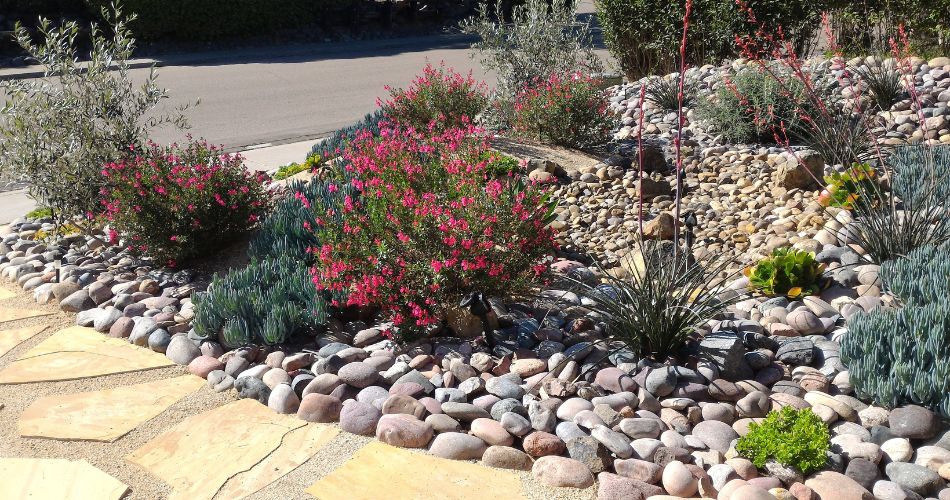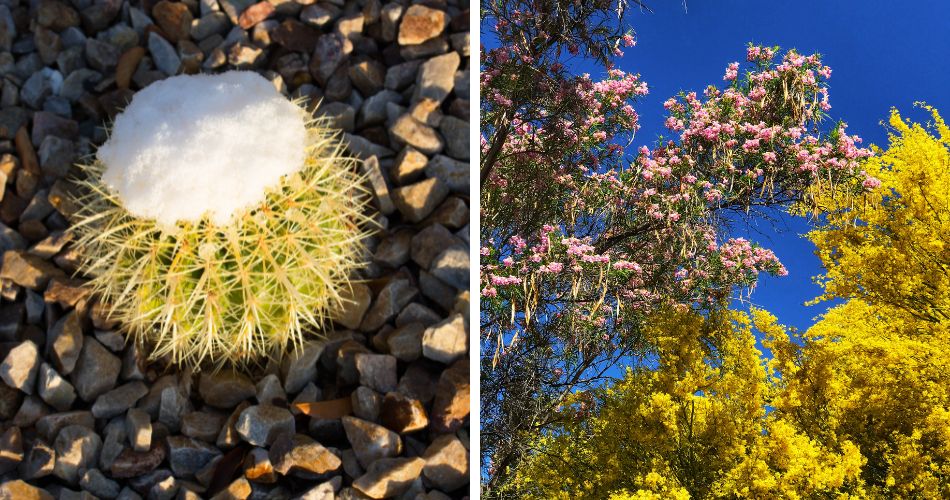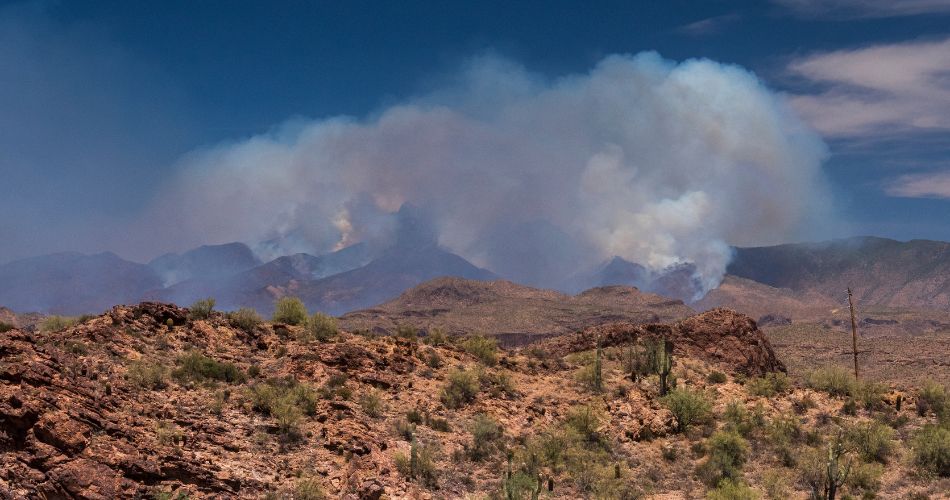
If you are new to Arizona, welcome! We’re glad to have you as part of the Grand Canyon state. If you have relocated or are planning to move to the Phoenix area, especially Anthem, Arizona, some things will be helpful to know about your new landscape, including the trees, shrubs, and overall climate.
In this article, we’ll walk through some things that may be helpful for new residents of Anthem, Arizona, and the surrounding areas, to know. Even if you’ve lived here a long time, you may learn something new!

Flagstaff, Arizona, in Northern Arizona, has a different climate than Phoenix, Arizona.
Arizona Has Many Climates
While many picture Arizona as a desert, that is not the entire state. Most of the Phoenix and Tucson areas are parts of the Sonoran Desert, but Northern Arizona has pine trees and snow-filled winters.
Arizona is the only state that has four separate deserts: the Chihuahuan Desert, the Mojave Desert, the Sonoran Desert, and the Great Basin Desert.
Thanks to the many mountain ranges in our state, you can experience many plant and wildlife communities on the same day. This is especially true in the Sky Islands, mountain ranges that have elevations of up to 10K feet.
Even some nearby hikes have significant elevation gain: you can gain 1,230 feet by hiking the Great Horned Owl loop to the Dixie Mountain loop in the Phoenix Sonoran Desert Preserve.
It Gets Very, Very Hot in Anthem
While other parts of the state commonly see snow, and there is the occasional brief snowfall here, the most common weather we see in Anthem is extremely hot temperatures.
Those that live in Maricopa County know to do any summer yard work during the early hours of the morning before the temperatures climb. We will choose parking spots in the shade (rather than close to the building), and many outdoor activities cease during the summer months.
As temperatures become even hotter every year, planting and maintaining trees becomes more and more important. Ensure that you have trees on your property, when possible, and that they are healthy, well-hydrated, and properly maintained.

You Will Need to Water Some Plants and Trees
Many homes in Anthem and the surrounding areas have irrigation systems to ensure that plants on the property receive enough water. Many homeowners are beginning to use rainwater harvesting to save money on water bills and to prevent any water waste.
While native trees rarely need to be watered once they are established, young trees will need to be watered slowly and deeply in the first few years to help them grow healthy roots.
How to Properly Water Young or Newly Planted Trees in the Desert
At Titan Tree Care, we offer soil amendments such as root drenches and soil injections that can increase water retention. This is especially helpful for non-native trees that have a harder time adapting to our dry climate.
How to Help Your Non-Native Plants and Trees Thrive on Your Phoenix Property

Consider Alternatives to Grass Lawns
Grass needs a lot of water to grow, and it doesn’t make much sense in a desert environment. Consider alternatives to grass lawns such as organic mulch, rocks, native groundcovers, or other organic materials.
Wood Mulch Vs. Rocks: Which is Best for Phoenix Area Yards?
Plant Native Trees and Plants Whenever Possible
When moving to Maricopa County from other climates, it can be tempting to plant what you are familiar with, but most plants, trees, and flowers grown in other parts of the country (or world) do not do well here.
Don’t assume that anything sold in a big box store’s garden center will do well in your Anthem yard, either.
For the highest chance of success, plant trees, plants, and flowers native to our area. They are best suited to survive our unique climate, work well with our wildlife, and benefit pollinators.
Note: If you live in the Anthem County Club Community, you can only plant trees, shrubs, and plants on the Approved Plant List.
We have many lists of recommended trees to plant on our website:
Choose the Right Tree for Your Phoenix Area Home
Best Shade Trees for Your Anthem or Greater Phoenix Yard
5 Excellent Evergreen Trees for the Anthem Area
5 Best Spring Flowering Trees for the Anthem Area
Best Palo Verde Trees for Phoenix Landscapes
8 of the Best Non-Native Trees for Phoenix

Anthem Has Seasons Too
Just because it is sunny most of the year does not mean there are no seasons in the Anthem, Arizona area. In fact, many consider Southern Arizona to have 5 seasons rather than 4.
Fall (October through December)
While you won’t see many leaves change on trees in Anthem to signal the fall season has begun, you will notice that temperatures are bearable again. There may even be some cool(er) nights!
It’s a great time of year to sit outside and view the stars. Keep light pollution down by choosing outdoor lighting that is Dark Sky Ordinance-approved.
Minimize Light Pollution with the Right Landscape Lighting for Your Outdoor Space
Winter (December Through February)
Though it is rare, we do have the occasional frost or freeze warnings if the temperatures get cold enough. When this happens, the local news will remind Anthem residents to care for their “pipes, pets, and plants.” That means wrapping any pipes that might break from freezing, bringing any outdoor pets indoors, and covering any outdoor plants that are frost sensitive.
Many citrus trees, for example, can suffer from frost damage. You may notice Styrofoam cups on the top of certain types of cacti (such as Mexican fence post cacti). This is to prevent frost damage.
If your plants are in pots, bring them indoors or set them in a garage (if you have one). Containers that can’t be moved or in-ground plants can be covered with a sheet. Just remember to take the sheet off the next day so that the sunlight can reach the plant and warm it up!
How to Prevent Winter Damage to Phoenix Area Trees and Plants
Most non-native plants and trees are sensitive to cold temperatures, so keep an eye on the weather in your area and plan accordingly.
Occasional rain is expected during the winter months, but some trees may need supplemental watering.
Trees, Shrubs, and Flowers to Add Winter Interest to Your Phoenix Yard
Spring (February through May)
Depending on how much winter rain there was during the preceding months, spring in Anthem can be filled with many colorful wildflowers, such as poppies and lupines. Our state tree, the palo verde, will erupt with bright yellow flowers, and, depending on the year, you may see other flowering trees bloom as well.
If you suffer from allergies, this tends to be the time of year that allergies plague the most people, thanks to trees and grasses that are spreading their pollen, high winds, and mild temperatures.
Do Palo Verde Trees Make You Sneeze?
If you’re worried about weeds on your property, many pre-emergent herbicides are applied in spring (before the summer rains) and in fall (before the winter rains).
5 Spring-Flowering Shrubs for Your North Phoenix Yard

Early Summer (May through early July)
The highest temperatures of the year usually occur during this season, right before the monsoon rains arrive and cool everything down for the day.
It is also a very dry time of year, and the chance of wildfires starting is high.
One of the things that are making fires in Arizona burn faster and hotter are invasive plants, especially an invasive grass called buffelgrass. This non-native plant grows rapidly among the saguaros and other native plants, dries out, and becomes the perfect fuel for fires to spread quickly.
While you may think that it is difficult to start a fire, according to Arizona Interagency Wildfire Prevention:
“The most common causes of wildfires in Arizona are dragging trailer safety chains, rims from flat tires striking pavement, vehicles parking or driving over dry vegetation, carelessly tossed cigarettes, abandoned campfires, equipment use and debris burning around homes and property, fireworks, and the discharge of firearms in areas with dry vegetation.”
Wildfires can be started quickly and spread rapidly. You can do your part by removing any invasive plants from your property, keeping your plants and trees well-watered, being careful when driving or smoking, and being aware of the fire dangers.
Also, avoid parking a vehicle over any dry grass or vegetation and never burn anything outdoors during extremely dry or windy conditions. There are occasionally “no burn” days where the air quality restricts burning wood outdoors (such as in a firepit or outdoor fireplace).
Some trees and plants, such as ocotillos, may lose their leaves during periods of drought. This is normal and one of the ways that trees and plants can survive the hot temperatures and lack of rainwater.
Monsoon (July through September)
Monsoon season is officially June 15 through September 30, but the average start date is July 7, and monsoon storms rarely occur past mid-September. Some also consider monsoon season to start around the time that cicadas begin to make noise.
While exciting, monsoons bring some danger thanks to dust storms, high winds, extreme temperatures, lightning, flooding, storm damage, and power outages.
Mosquitoes, which take advantage of the pools of water created by monsoon storms, are becoming more and more of an issue in Maricopa County as well.

Haboobs or Dust Storms
Many monsoons begin with a large dust storm, known as a haboob. They can appear quickly and without warning. It can be dangerous to drive in a dust storm as visibility is greatly reduced. Check out these tips for driving in dust storms.
Microbursts
Microbursts are small but intense storms that can cause a lot of damage. According to the National Weather Service, they can reach speeds of up to 150 mph and can be more destructive than some tornadoes. Less than 2.5 miles in scale, microbursts occur when air sinks during a thunderstorm (or monsoon).

Monsoons, Flooding, and Storm Damage
A monsoon is “any wind that reverses its direction seasonally.” When the wind shifts in Maricopa County, we receive winds from the south and southeast, bringing moisture from the Gulf of Mexico, the Pacific Ocean, and the Gulf of California.
As that moisture meets our extremely high temperatures, the explosive result is a monsoon storm.
These strong thunderstorms have high winds and significant rainfall, during which a lot of waterfalls in a short period of time. This combination can lead to flash floods, broken or uprooted trees, power outages, and dangerous conditions. Roads can be washed away from a rushing wash (a riverbed that is often completely dry during other times of the year).
Some areas provide sandbags to be used as temporary protection against flooding.
The good news is monsoons bring needed rain, they drop the temperature for a few hours, and our plants, trees, and cacti soak up the moisture. Many people plant “monsoon gardens,” as the monsoon season is a great time to plant flowers, vegetables, and herbs.
How to Prevent Tree Damage During Phoenix Monsoon Season
Lightning
Due to the extreme nature of monsoons, they are often accompanied by a lot of thunder and lightning. Lightning striking a tree or a palm can start a fire, and wildfire danger is still high during this time of year.
Lightning can also harm humans, so as the saying goes, “When thunder roars, head indoors.”
Lightning in Arizona – What Happens When Lightning Hits a Tree?
Mosquitoes
Mosquitoes, and the diseases that they carry, are becoming more prevalent in Maricopa County. Monsoon rains can increase the population of mosquitoes. Remember, mosquitoes only need as much as a soda bottle cap full of water in which to lay eggs.
Why You Should be Concerned About Mosquitoes in Phoenix
In Summary
If you are new to the area, the most important things to remember are:
- Phoenix-area plants and trees are different from plants and trees that grow elsewhere
- Adding trees can help with the rising temperatures
- Native plants and trees will do best, especially those that receive water, proper pruning, and maintenance
- We have distinct seasons during which different tree care is required
- The weather can be extreme, from high temperatures to wildfires to monsoon storms
- Non-native plants and trees will need extra care to survive
If you have any questions about your trees or want to schedule a property inspection, contact Titan Tree Care. We can help you keep your trees safe, prevent tree pests, and remove any trees that can become a hazard.
More Articles Like This

Titan Tree Care is a full-service tree care company located in Anthem, AZ and serving all of North Phoenix. We offer a wide range of services to meet your tree care needs, including tree and palm trimming, tree pruning, tree removal, stump grinding, and more. We also offer insect or disease treatments and fertilization services. We are dedicated to providing high-quality, safe, and effective tree care services to our customers and work hard to ensure that your trees are healthy and look their best.









